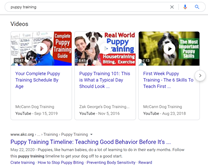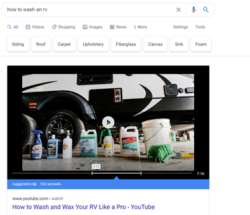Every marketer knows video can be a powerful tool to harness in their campaigns. From brand awareness and customer stories to technical explainer videos, we continue to see the rise of video and its effectiveness. After all, it’s engaging, shareable and measurable. But did you know video content can also be an important ingredient for SEO—and boosting organic reach?
A recent global survey by HubSpot showed that, “video is the #1 form of media used in content strategy, overtaking blogs and infographics.” So, if you’re thinking about incorporating video into your marketing programs or looking for ways to optimize content plans, here’s why to invest in video.
Improve user experience
If there is one thing that we’ve learned from the most recent Google Core Algorithm Updates, it’s the importance of providing a positive user experience on your website. A big part of these updates is continuing to push websites to provide the best content they can to users.
Experts predict that more than 80% of all consumer traffic will be videos by 2021. This is because video is extremely effective for storytelling and selling. Take product videos for example. They can not only help educate on how products work or benefit customers, but they can dive deeper into the technical components and key differentiators in a personable and engaging way. After all, users tend to remember what they saw in a video more often than what they read in a blog post.
For brands with complex offerings, videos can be a valuable way to explain, educate or provide interesting insights around their solutions. In fact, 95% of video marketers surveyed by Wyzowl said they felt video helped increase the understanding of their products or service.
Earn SERP features
If you’re not familiar with SERP features, they are a result on a search engine page that isn’t a traditional result. Think paid ads, product ratings, images and so on. In the good ole days, you could optimize a page by repeating your keyword multiple times. Google eventually caught on to this tactic though and shifted its focus from keywords to a user's intent behind a search with the release of the Hummingbird algorithm.
So, how does video fit into all this? Due to the growing popularity of consuming video, Google will now display videos on its results page (hello, SERP features) for certain informational and educational search terms. We often see this trend with “how to” based keywords and topics like “how to ride a bike.”
Two popular SERP Features for video are the video carousel and featured snippets:
Video carousels
This format allows Google to show multiple videos related to a topic, which not only keeps the user scrolling the search engine but provides more resources for answering a user's question.

When it comes to getting a video carousel feature, you can get a leg up on the competition by hosting your videos on YouTube. You can also try to score a feature by embedding videos on your pages. Just be sure to apply VideoObject structured data to your embedded videos to optimize your pages. Applying this markup tells search engines exactly what type of content it is and provides additional important information like description, title and so on.
Featured snippets

Earning featured snippets should be a top priority for any SEO-driven content strategy. Why, you may ask? Because over 50% of all searches are answered directly in SERP as featured snippets. You might be more familiar with traditional types of featured snippets like a listicle or paragraph, but like we mentioned above, videos can also earn this top spot depending on the intent of the keyword.
Boost search rankings
As an industry, we need to revise the phrase “content is king” to “QUALITY content is king.” Users who search for information want the best and most relevant answer to solve their problem. In response, Google has placed a greater emphasis on quality factors to ensure this happens.
In general, video is considered a piece of high-quality content. So, by integrating video on your site, you are sending signals to the search engines that your site has quality content and you’re adding more value on a page that is relevant to a search term.
Refresh and reinvigorate content
At LoSasso, one key ingredient to our ongoing content strategy for many of the B2B or high-consideration brands we work with is to refresh older content or posts that are seeing a dip in traffic. For some of these posts, we may even turn the content into a video rather than updating a post with even more technical information. By doing so, we’ve made the information more easily digestible and engaging—something consumers love. We’ll also take note of other posts that rank higher without video and sometimes add video content as support to help differentiate our post from the competition.
Want to see a real-world example of a post refresh? Take a look at this post we did for a client. Already chock full of technical information that their audience loves, we we’re able to add educational video content that provided further detail—and interest. In fact, the refreshing the post improved its search rank for highest priority search term, which contributed to organic visits increasing YOY.
Whether you’re looking to educate your audience, build excitement or just drive awareness of your brand, video is an effective and valuable way to connect with an audience. Add the fact that it can add to your SEO value, and it’s no wonder the majority of businesses are looking for ways to produce more video content—and reap the search rewards.


